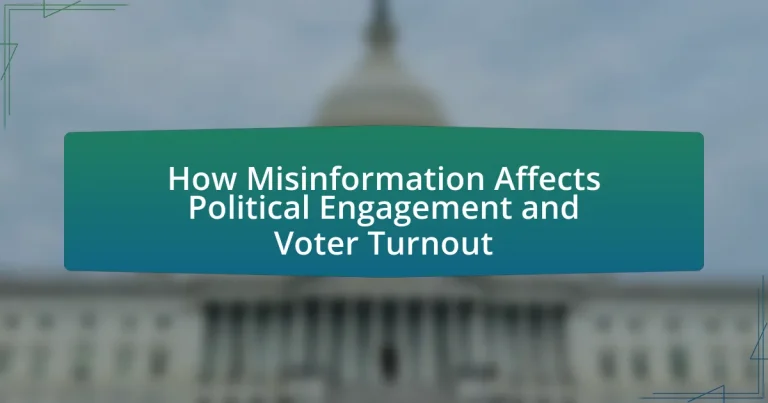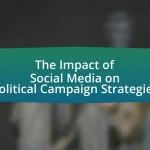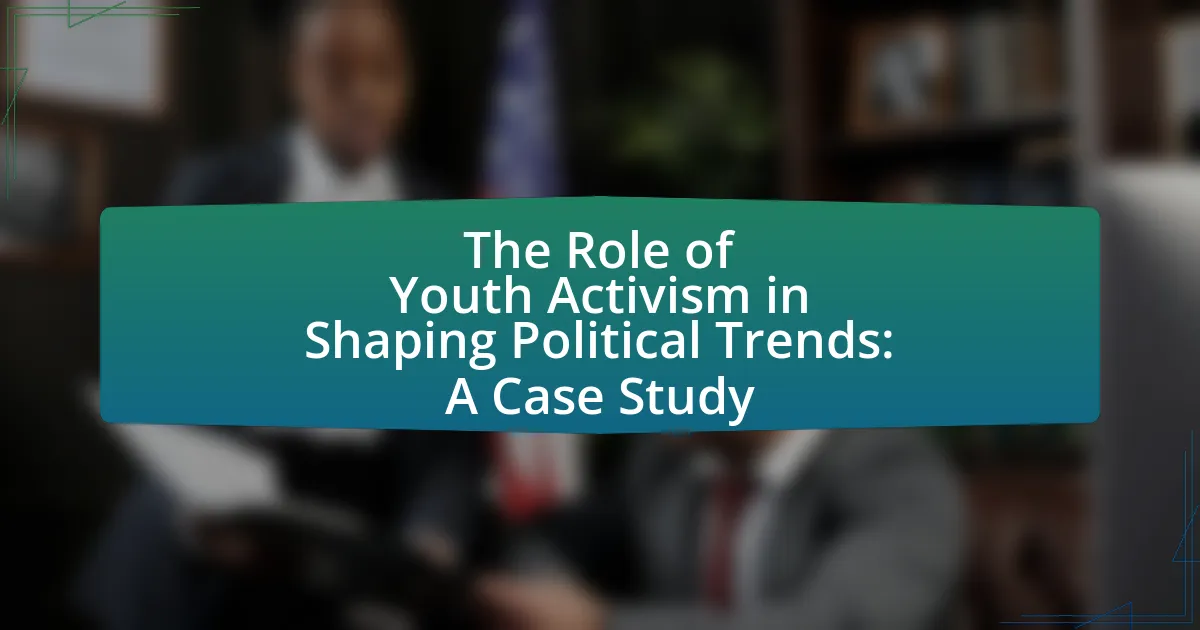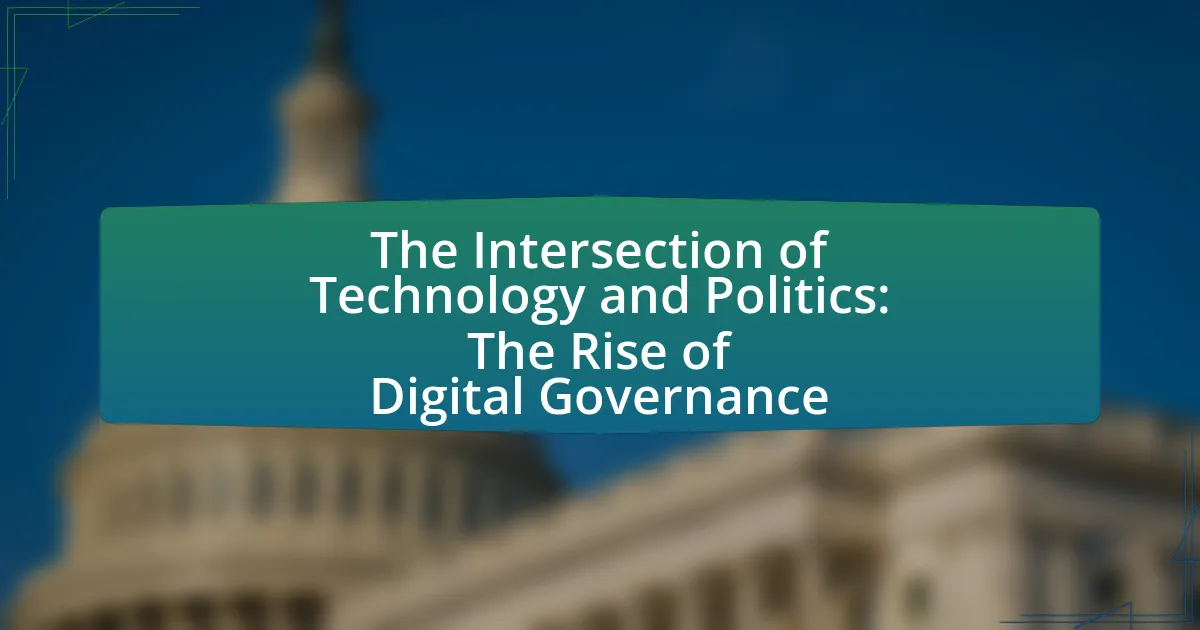Misinformation plays a critical role in shaping political engagement and voter turnout by distorting public perceptions and influencing behaviors. It encompasses various forms, including disinformation, malinformation, and fake news, each contributing to increased polarization and misinformed voting decisions. Social media platforms amplify the spread of misinformation, exacerbating cognitive biases such as confirmation bias, which leads individuals to accept information that aligns with their beliefs. The article explores the impact of misinformation on voter trust, motivation, and engagement, highlighting demographic factors that influence susceptibility and strategies to combat misinformation through media literacy and fact-checking initiatives.
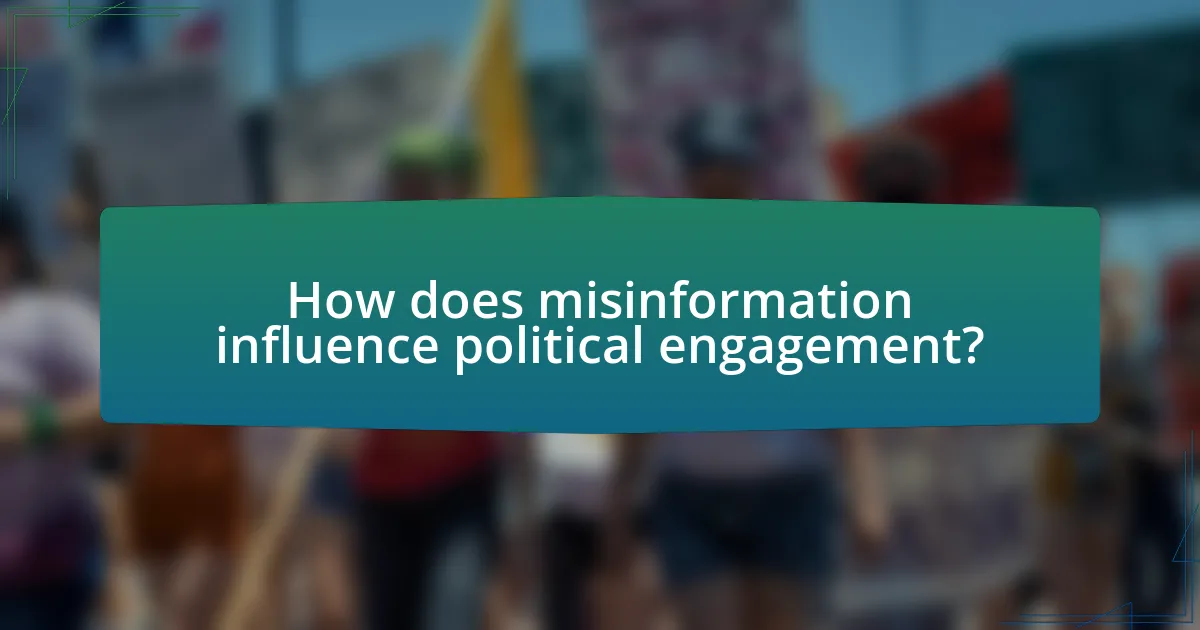
How does misinformation influence political engagement?
Misinformation significantly influences political engagement by shaping public perceptions and behaviors. It can lead to increased polarization, as individuals may become more entrenched in their beliefs when exposed to false information that aligns with their views. Studies, such as one published in the journal “Science,” indicate that misinformation can enhance voter turnout by creating a sense of urgency or fear, prompting individuals to engage politically. Additionally, misinformation can distort the understanding of key issues, leading to misinformed voting decisions, as evidenced by research from the Pew Research Center, which found that a substantial portion of the public encounters false information related to politics.
What are the different types of misinformation affecting politics?
The different types of misinformation affecting politics include disinformation, misinformation, malinformation, and fake news. Disinformation refers to false information deliberately spread to deceive, often for political gain, such as fabricated stories about candidates. Misinformation is incorrect information shared without malicious intent, like misinterpreted statistics. Malinformation involves the use of truthful information to harm individuals or groups, such as selectively presenting facts to mislead voters. Fake news encompasses entirely fabricated stories presented as news, which can significantly influence public opinion and voter behavior. Studies have shown that exposure to misinformation can lead to decreased voter turnout and increased polarization, highlighting its impact on political engagement.
How does fake news differ from disinformation and malinformation?
Fake news is a specific type of misinformation that is fabricated and presented as news, often to mislead or manipulate public opinion. In contrast, disinformation refers to false information that is deliberately spread with the intent to deceive, while malinformation involves the sharing of true information with the intent to harm or mislead. For example, fake news might include entirely made-up stories about a political candidate, disinformation could involve selectively presenting facts to create a false narrative, and malinformation might involve leaking true but damaging information about a public figure to undermine their reputation.
What role do social media platforms play in spreading misinformation?
Social media platforms play a significant role in spreading misinformation by facilitating rapid dissemination of false information to large audiences. The algorithms used by these platforms often prioritize engagement over accuracy, leading to the viral spread of misleading content. For instance, a study published in the journal Science found that false news stories are 70% more likely to be retweeted than true stories, highlighting the platforms’ impact on the spread of misinformation. Additionally, the anonymity and ease of sharing on social media allow users to propagate unverified claims without accountability, further exacerbating the issue.
Why do individuals engage with misinformation?
Individuals engage with misinformation primarily due to cognitive biases and social influences. Cognitive biases, such as confirmation bias, lead individuals to seek out and accept information that aligns with their pre-existing beliefs, while dismissing contradictory evidence. Social influences, including group dynamics and the desire for social acceptance, further encourage the sharing and perpetuation of misinformation within communities. Research indicates that misinformation can spread rapidly through social networks, with studies showing that false information is 70% more likely to be retweeted than true information, highlighting the role of social media in amplifying these effects.
What psychological factors contribute to the acceptance of misinformation?
Cognitive biases significantly contribute to the acceptance of misinformation. These biases, such as confirmation bias, lead individuals to favor information that aligns with their pre-existing beliefs while dismissing contradictory evidence. Research indicates that people are more likely to accept misinformation when it resonates with their ideological views, as shown in studies like the one by Lewandowsky et al. (2012), which highlights how individuals selectively process information to reinforce their beliefs. Additionally, the Dunning-Kruger effect suggests that individuals with lower knowledge levels may overestimate their understanding, making them more susceptible to accepting false information. These psychological factors create an environment where misinformation can thrive, particularly in politically charged contexts, influencing voter behavior and engagement.
How does confirmation bias affect political beliefs and engagement?
Confirmation bias significantly influences political beliefs and engagement by causing individuals to favor information that aligns with their pre-existing views while dismissing contradictory evidence. This cognitive bias leads to the reinforcement of partisan perspectives, as people selectively seek out news sources and social media content that confirm their beliefs, resulting in echo chambers. Research indicates that individuals exposed to politically congruent information are more likely to engage in political activities, such as voting or activism, as they feel validated in their opinions. For example, a study by the Pew Research Center found that 62% of social media users encounter news that reinforces their political views, which can increase political participation among like-minded individuals.
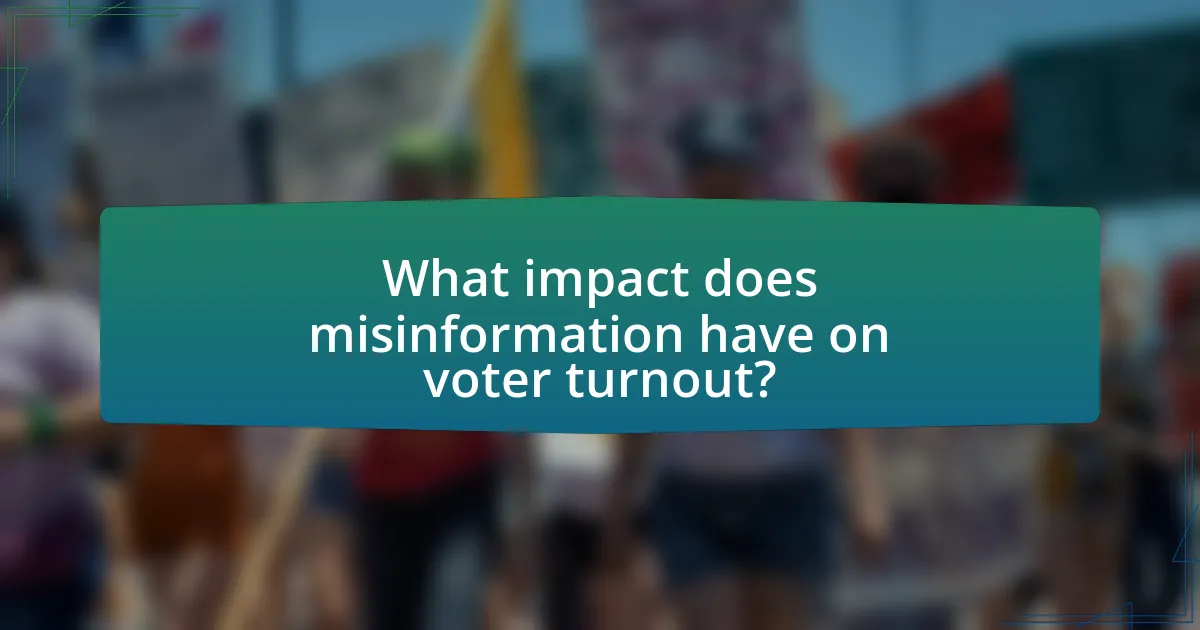
What impact does misinformation have on voter turnout?
Misinformation significantly decreases voter turnout by creating confusion and distrust among potential voters. Studies indicate that exposure to false information can lead to apathy and disengagement from the electoral process. For instance, a 2020 study by the Pew Research Center found that 64% of Americans reported feeling overwhelmed by the amount of misinformation, which negatively impacted their likelihood to vote. Additionally, misinformation can mislead voters about voting procedures, such as registration deadlines and polling locations, further discouraging participation.
How does misinformation shape voter perceptions and decisions?
Misinformation significantly shapes voter perceptions and decisions by distorting the information landscape, leading to misinformed beliefs and choices. Studies indicate that exposure to false information can alter voters’ understanding of candidates and issues, often resulting in biased opinions and voting behavior. For instance, research published in the journal “Political Communication” found that individuals who encountered misinformation were more likely to hold inaccurate beliefs about political candidates, which directly influenced their voting preferences. This distortion can create a feedback loop where misinformation reinforces existing biases, further entrenching voters in their misconceptions and affecting overall electoral outcomes.
What are the consequences of misinformation on voter trust in the electoral process?
Misinformation significantly undermines voter trust in the electoral process by creating doubt about the integrity and fairness of elections. When voters encounter false information regarding voting procedures, candidate qualifications, or election outcomes, their confidence in the system diminishes. Research conducted by the Pew Research Center in 2020 found that 64% of Americans believe misinformation has a major impact on public confidence in elections. This erosion of trust can lead to decreased voter turnout, as individuals may feel disillusioned or skeptical about the effectiveness of their participation. Furthermore, a study published in the journal “Political Behavior” in 2021 indicated that exposure to misinformation correlates with increased political apathy, further exacerbating the challenges of engaging citizens in the democratic process.
How does misinformation affect voter motivation and apathy?
Misinformation significantly decreases voter motivation and increases apathy. When voters encounter false or misleading information, it can lead to confusion about candidates, policies, and the electoral process, ultimately diminishing their desire to participate in elections. Research by the Pew Research Center indicates that 64% of Americans believe misinformation has a major impact on their understanding of political issues, which can result in disengagement from the voting process. Additionally, studies show that exposure to misinformation can create a sense of hopelessness among voters, as they may feel their votes do not matter in a distorted political landscape. This cycle of misinformation and disengagement can lead to lower voter turnout, as individuals become disillusioned and less likely to engage in civic activities.
What demographic factors influence susceptibility to misinformation?
Age, education level, and political affiliation are key demographic factors influencing susceptibility to misinformation. Research indicates that younger individuals, particularly those aged 18-29, are more likely to encounter and share misinformation due to their higher engagement with social media platforms. Additionally, individuals with lower education levels tend to have a higher susceptibility to misinformation, as they may lack critical thinking skills necessary for evaluating information sources. Political affiliation also plays a significant role; individuals who strongly identify with a political party may be more inclined to accept misinformation that aligns with their beliefs, as shown in studies highlighting confirmation bias. These factors collectively contribute to the varying degrees of vulnerability to misinformation across different demographic groups.
How do age, education, and political affiliation affect vulnerability to misinformation?
Age, education, and political affiliation significantly influence an individual’s vulnerability to misinformation. Research indicates that younger individuals, particularly those aged 18-29, are more susceptible to misinformation due to their higher engagement with social media platforms where false information proliferates. In contrast, older adults often exhibit greater skepticism towards online content but may still fall prey to misinformation that aligns with their pre-existing beliefs.
Education plays a crucial role, as individuals with higher levels of education tend to possess better critical thinking skills, enabling them to discern credible information from falsehoods. A study published in the journal “Science Advances” found that individuals with a college degree are less likely to share misinformation compared to those with lower educational attainment.
Political affiliation also affects vulnerability; individuals who strongly identify with a political party are more likely to accept misinformation that supports their views while dismissing opposing information. This phenomenon is supported by research from the Pew Research Center, which shows that partisan biases can lead to selective exposure to information, reinforcing existing beliefs and increasing susceptibility to misinformation that aligns with those beliefs.
What strategies do different demographic groups use to navigate misinformation?
Different demographic groups employ various strategies to navigate misinformation, including fact-checking, media literacy education, and reliance on trusted sources. For instance, younger individuals often utilize social media platforms to cross-reference information and engage in discussions, while older adults may prefer traditional news outlets and community resources for verification. Research indicates that individuals with higher education levels are more likely to engage in critical thinking and fact-checking behaviors, which enhances their ability to discern credible information. Additionally, minority groups may rely on culturally relevant sources and community leaders to filter misinformation, as highlighted in studies examining the impact of misinformation on voter turnout among diverse populations.
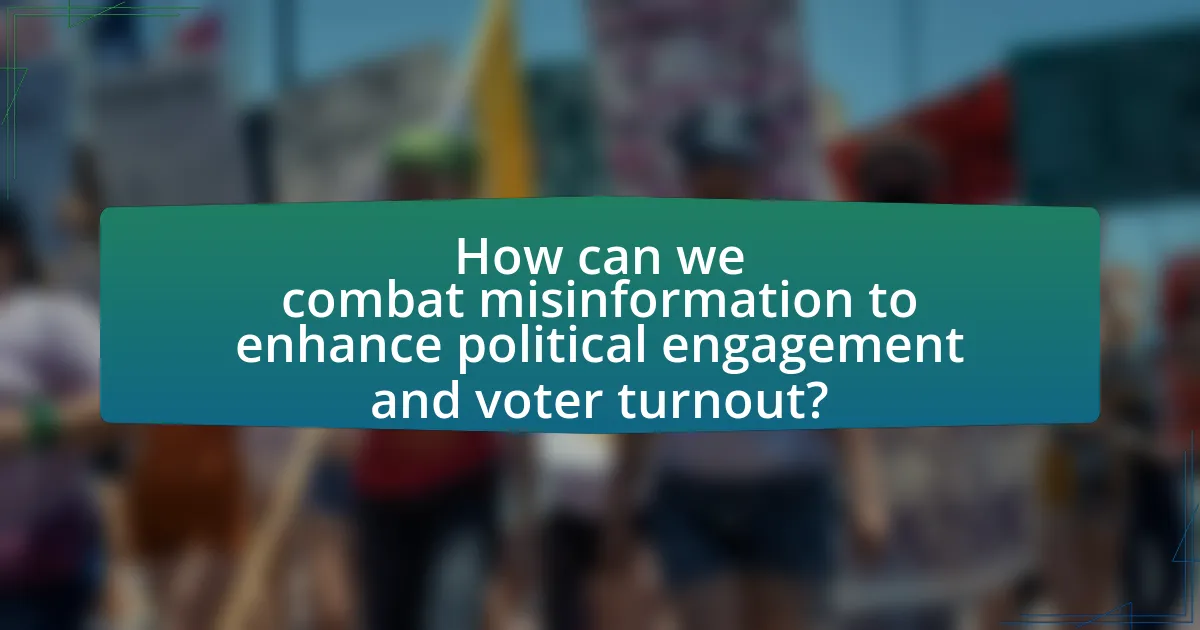
How can we combat misinformation to enhance political engagement and voter turnout?
To combat misinformation and enhance political engagement and voter turnout, implementing comprehensive media literacy programs is essential. These programs educate citizens on identifying credible sources and understanding the impact of misinformation on democratic processes. Research indicates that individuals exposed to media literacy training are more likely to critically evaluate information, leading to informed voting decisions. For instance, a study by the Stanford History Education Group found that students who received media literacy instruction improved their ability to discern credible information by 50%. Additionally, collaboration between social media platforms and fact-checking organizations can effectively reduce the spread of false information, as evidenced by Facebook’s partnership with independent fact-checkers, which has led to a significant decrease in the visibility of misleading content.
What are effective strategies for educating voters about misinformation?
Effective strategies for educating voters about misinformation include implementing comprehensive media literacy programs, promoting fact-checking resources, and utilizing social media campaigns to disseminate accurate information. Media literacy programs enhance critical thinking skills, enabling voters to analyze and evaluate information sources effectively. Research indicates that individuals who participate in media literacy initiatives are better equipped to identify misinformation (Hobbs, 2017). Additionally, promoting fact-checking resources, such as Snopes or FactCheck.org, provides voters with reliable tools to verify claims before sharing them. Social media campaigns can leverage platforms like Facebook and Twitter to reach a broad audience, using engaging content to highlight the dangers of misinformation and encourage responsible sharing practices. These strategies collectively empower voters to make informed decisions and reduce the impact of misinformation on political engagement and voter turnout.
How can media literacy programs improve critical thinking skills among voters?
Media literacy programs can improve critical thinking skills among voters by equipping them with the tools to analyze and evaluate information sources critically. These programs teach individuals how to discern credible information from misinformation, which is essential in a media landscape saturated with biased and misleading content. Research indicates that participants in media literacy initiatives demonstrate enhanced abilities to question the validity of news sources and recognize logical fallacies, leading to more informed decision-making during elections. For instance, a study by the National Association for Media Literacy Education found that students who underwent media literacy training showed a 30% increase in their ability to identify biased reporting. This improvement in critical thinking directly correlates with voters’ capacity to engage thoughtfully with political content, ultimately fostering a more informed electorate.
What role do fact-checking organizations play in combating misinformation?
Fact-checking organizations play a crucial role in combating misinformation by verifying claims and providing accurate information to the public. These organizations analyze statements made by public figures, media outlets, and social media posts, assessing their truthfulness based on evidence and reliable sources. For instance, a study by the Pew Research Center found that 64% of Americans believe that fact-checking helps them identify misinformation. By disseminating verified information, fact-checking organizations help to reduce the spread of false narratives, thereby fostering informed political engagement and potentially influencing voter turnout.
What best practices can individuals adopt to minimize the impact of misinformation?
Individuals can minimize the impact of misinformation by critically evaluating sources before accepting information as true. This involves checking the credibility of the source, looking for corroborating evidence from reputable outlets, and being aware of potential biases in the information presented. Research indicates that individuals who engage in fact-checking and seek multiple perspectives are less likely to be influenced by false information. For instance, a study published in the journal “Science” found that individuals who actively verify claims are more adept at distinguishing between accurate and misleading information, thereby reducing the spread of misinformation in political contexts.
How can voters verify the credibility of information sources?
Voters can verify the credibility of information sources by cross-referencing facts with reputable organizations and checking the author’s credentials. Reputable organizations, such as fact-checking websites like Snopes or PolitiFact, provide verified information that can confirm or debunk claims. Additionally, examining the author’s background, including their expertise and previous work, helps assess the reliability of the information presented. Studies show that voters who engage in fact-checking are more informed and less susceptible to misinformation, thereby enhancing their political engagement and turnout.
What steps can individuals take to engage in constructive political discourse despite misinformation?
Individuals can engage in constructive political discourse despite misinformation by critically evaluating sources, verifying facts, and promoting open dialogue. Critical evaluation involves assessing the credibility of information sources, such as checking the author’s qualifications and the publication’s reputation. Verifying facts can be achieved through fact-checking websites, which have been shown to reduce the spread of false information; for instance, a study by the Pew Research Center found that fact-checking can significantly influence public perception of political claims. Promoting open dialogue encourages respectful conversations where differing viewpoints are acknowledged, fostering understanding and reducing polarization. Engaging in these steps helps individuals navigate misinformation effectively and contributes to a healthier political discourse.
